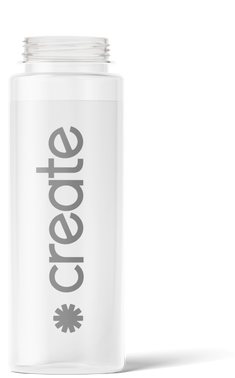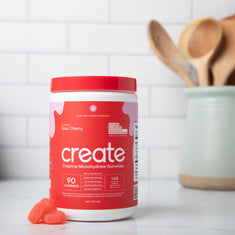Unraveling The Puzzle: Exploring Creatine Monohydrate Structure
Cracking The Code: Decoding The Creatine Monohydrate Structure
Are you curious about the molecular structure of creatine monohydrate and its benefits? Ever since it was first discovered to be a part of normal metabolism years ago, creatine has been extensively studied. This amazing compound is a natural source of energy that has gained popularity as an ergogenic supplement among professional athletes and bodybuilders alike, giving them more energy to last longer and build muscle faster.
If you consider taking the best quality creatine to make yourself healthier and stronger, consider Create’s gummies. Our all-natural, friendly gummies are tasty, convenient, and easy to transport. So, don't wait and get your hands on the best supplement available on the market.
What Is The Chemical Composition Of Creatine Monohydrate?
The chemical composition of creatine monohydrate can be described using its molecular formula and the components that make up its structure.
Molecular Formula
The molecular formula of creatine monohydrate is C4H9N3O2.H2O. This formula represents the arrangement and types of atoms present in creatine monohydrate.
Carbon (C)
Carbon is a key element in organic compounds, forming strong covalent bonds with other carbon atoms and other elements such as hydrogen, nitrogen, and oxygen. In creatine monohydrate, there are four carbon atoms that form the backbone of the molecule. This backbone provides stability and structure to the molecule.
Hydrogen (H)
In organic compounds, hydrogen atoms are typically attached to carbon atoms, forming hydrocarbon chains. Hydrogen atoms also participate in chemical reactions, providing electrons for bonding with other atoms. In creatine monohydrate, there are nine hydrogen atoms attached to various carbon and nitrogen atoms.
Nitrogen (N)
Nitrogen is an essential element in amino acids, which are the building blocks of proteins. In creatine monohydrate, there are three nitrogen atoms that play a crucial role in the molecule's structure and function. These atoms form the amino group in creatine, which is important for the compound's ability to donate a phosphate group during energy metabolism.
Oxygen (O)
Oxygen is involved in the formation of chemical bonds and plays a critical role in various biological processes. In creatine monohydrate, there are five oxygen atoms that contribute to the overall structure of the molecule. These atoms form the carbonyl and carboxyl groups, which are important for the molecule's stability and reactivity.
Water (H2O)
The "monohydrate" component in creatine monohydrate refers to the presence of one molecule of water. This water molecule is loosely bound to the creatine molecule and contributes to the overall structure of creatine monohydrate.
How Does The Crystal Structure Of Creatine Monohydrate Form?
The crystal structure of creatine monohydrate refers to the arrangement and organization of individual molecules within the solid state of the compound. X-ray crystallography is commonly used to determine and study the crystal structure of creatine monohydrate. Here is an overview of the crystal structure of creatine monohydrate:
Space Group
Creatine monohydrate belongs to the triclinic crystal system, which is one of the seven crystal systems in crystallography. Its space group is P1, indicating that the crystal structure possesses no additional symmetry elements.
Unit Cell
The unit cell is repeated in three dimensions and forms the crystal lattice. The unit cell of creatine monohydrate is triclinic in shape and contains multiple creatine monohydrate molecules and water molecules.
Molecule Arrangement
Within the crystal lattice, the creatine monohydrate molecules and water molecules are arranged in an organized pattern. The creatine molecules are connected through intermolecular forces such as hydrogen bonding, forming a three-dimensional network.
Intermolecular Forces
Hydrogen bonding is a prominent intermolecular force observed in the crystal structure of creatine monohydrate. Hydrogen bonds form between the nitrogen and oxygen atoms of adjacent creatine molecules and water molecules, contributing to the stability and structure of the crystal lattice.
Crystal Shape
Creatine monohydrate crystals often exhibit irregular shapes and can vary in size. During crystallization, variables like nucleation and growth conditions have an impact on the specific crystal shape.
Why Is The Structure Of Creatine Monohydrate Significant?
The structure of creatine monohydrate holds great significance as it directly influences its properties, functions, and interactions within the body. Here are some key points highlighting the significance of the structure:
Absorption And Bioavailability
The structure of creatine monohydrate impacts its absorption and bioavailability in the body. The ease with which it can dissolve and enter the gastrointestinal tract, allowing it to reach target tissues and have an impact, depends on its crystal structure and intermolecular forces.
Stability
The structure of creatine monohydrate affects its stability, particularly in different environmental conditions such as temperature and humidity. Understanding its crystal structure helps in developing appropriate storage and formulation strategies to maintain its stability over time.
Solubility
The structure of creatine monohydrate influences its solubility in water and other solvents. Solubility plays a role in determining the ease with which creatine monohydrate can dissolve and become available for cellular uptake and utilization.
Chemical Reactivity
The structural composition of creatine monohydrate influences its chemical reactivity. It may participate in various enzymatic reactions and metabolic pathways, impacting energy metabolism and cellular processes.
Function And Efficacy
The structure of creatine monohydrate is intricately linked to its function and efficacy as a sports and fitness supplement. The way it is structured determines its ability to serve as a readily available source of energy during high-intensity activities, promoting increased power and muscle performance.
Molecular Interactions With The Body
The specific arrangement of atoms and intermolecular forces within the structure of creatine monohydrate facilitates interactions with other molecules in the body. These interactions may include binding to enzymes, transporters, and receptors, affecting various physiological processes.
Formulation And Delivery Systems
Knowledge of the structure of creatine monohydrate aids in designing effective formulations and delivery systems to enhance its stability, solubility, and bioavailability. This can lead to improved product formulations, such as micronized creatine or creatine complexes with enhanced characteristics.











